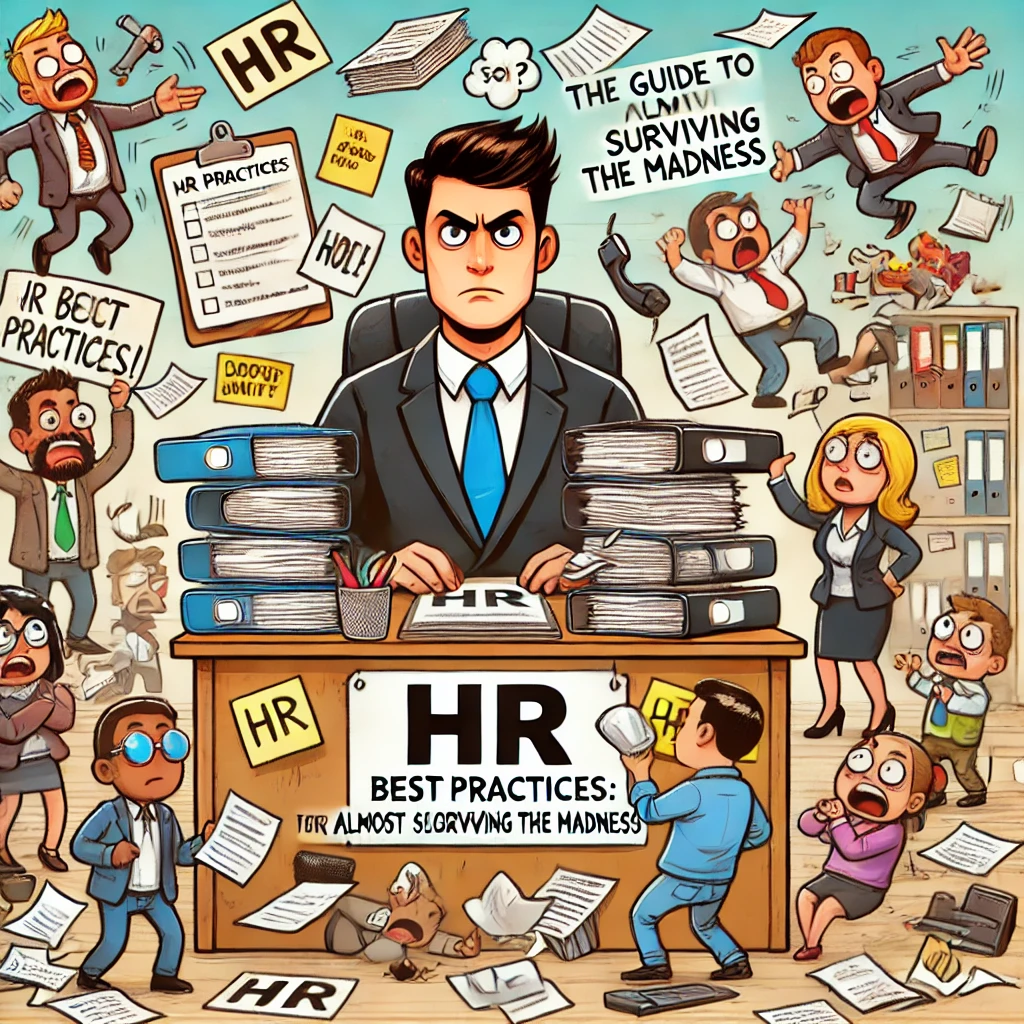HR Best Practices: The Guide to (Almost) Surviving the Madness

Ah, HR—the glamorous world of employee handbooks, compliance training, and the occasional intervention in coffee machine disputes. If you think HR is all about high-flying boardroom strategies, think again! It’s about juggling roles from therapist to detective, and sometimes—if you’re lucky—you get to explain why “Bring Your Pet to Work Day” doesn’t mean bringing a python.
So, buckle up! Here’s our slightly less-than-traditional guide to HR best practices for those brave souls in Human Resources who manage to keep their sanity (mostly) intact.
1. Hire Right or Face the Fright
Best Practice: Hire the right people for the right roles.
What Actually Happens: Hiring is like a blind date that lasts forever, but instead of wondering if they like dogs, you’re hoping they don’t mention their pet rock collection during the interview.
Reality Check: There’s no crystal ball, but do the best you can with interviews, background checks, and that suspicious gut feeling you get when a candidate says their greatest weakness is “trying too hard.” Remember, if you rush through hiring, you might end up with Bob from Accounts who thinks “reply all” is the best way to share cat memes.
2. Training: Teach ‘em or Regret ‘em
Best Practice: Implement a robust training program to get new hires up to speed.
What Actually Happens: You plan a detailed training session, complete with engaging materials, breakout sessions, and… daydreaming employees who look like they’d rather be anywhere else. Even in traffic.
Pro Tip: Spice it up! Gamify learning with quizzes, challenges, and prizes (everyone loves a gift card). Just don’t make the training sound like the terms and conditions we all scroll past when updating our phones.
3. Performance Reviews: The Annual Showdown
Best Practice: Conduct fair and transparent performance reviews.
What Actually Happens: Performance reviews often feel like reality TV auditions. There’s drama, a few tears, and a contestant—er, employee—who insists they should have been promoted to “Chief Strategy Wizard” months ago.
Reality Check: Use data and examples to back up feedback, and always provide a path for growth. If someone responds with, “Are you serious?” remember: it’s not about them being shocked; it’s about you having to explain why Timmy got the promotion because he didn’t nap during team calls.
4. Employee Engagement: Yes, Snacks Do Count
Best Practice: Keep employees engaged through meaningful activities and initiatives.
What Actually Happens: Employee engagement can sometimes boil down to awkward icebreakers and “Pizza Fridays.” And nothing says “I value you” like free carbs.
The Fix: Move beyond pizza (even if it’s hard). Create an environment where people feel heard, respected, and recognized. And if that fails… bring on the snacks.
5. Open Door Policy: The One That Never Closes
Best Practice: Maintain an open-door policy to encourage communication.
What Actually Happens: If you have an open door policy, it’s best paired with a bottomless coffee cup. Be prepared for everything from, “Can we have standing desks?” to, “I think Sharon’s lunch keeps eyeballing me.”
Survival Tip: Listen actively, but set boundaries. Remember, HR’s open-door policy isn’t code for “Come vent about the printer jam for 45 minutes.”
6. Compliance: The Ultimate Buzzkill
Best Practice: Ensure compliance with all legal regulations and company policies.
What Actually Happens: As soon as the word “compliance” is mentioned, employees develop selective hearing. “Dress code? Nah, that’s just a guideline, right?” Spoiler: it’s not.
Sanity Tip: Use humor and visuals when explaining policies (yes, even compliance). Memes work wonders for explaining why certain forms aren’t optional. And if all else fails, throw in a dramatic reading of the HR handbook. Nothing grabs attention like “Article 4, Subsection 2…”
7. Managing Conflict: HR’s Favorite Sport
Best Practice: Resolve workplace conflicts fairly and professionally.
What Actually Happens: HR’s conflict resolution is like a soap opera: people get emotional, someone’s reputation is on the line, and there’s a constant twist—“Wait, who stole the office plant?!”
Pro Tip: Step into conflict with empathy and a detective’s mindset. Ask probing questions and always remember to repeat, “I’m not taking sides… except for the side of peace and harmony.”
8. Employee Retention: Don’t Let Them Escape!
Best Practice: Create a culture that retains top talent.
What Actually Happens: Employee turnover sometimes feels like a revolving door—especially after a single memo about changing the brand of office coffee.
HR Hack: Don’t just focus on paychecks and perks; invest in people’s career paths. And hey, throw in a surprise “No Meeting Monday” every now and then. Retention sometimes comes down to small wins (like less time on Zoom).
Final Thoughts
HR is a wild ride of balancing policies with people, regulations with real-world chaos, and—every so often—managing the great sticky note war between Finance and Marketing. While best practices are crucial, sometimes the reality is just finding ways to keep everyone happy, productive, and not at each other’s throats.
So, if you’re an HR pro trying to survive (or thrive), just remember: the best HR practice is this—maintain your sense of humor. Because when your day involves resolving a debate on whether the office microwave is a “public good,” sometimes all you can do is laugh.
Feel free to share your own wild HR stories in the comments below! After all, we’re all in this madness together. 😄






Responses